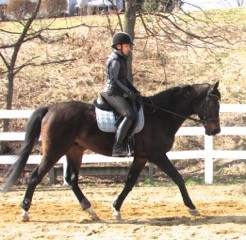Riding horses is something that we do with kinesthetic feeling. It is very unique because there is no other sport, which I am aware of, where you straddle an animal. Many riders who take on this activity try to analyze what they are doing when riding, and the best riders are the ones that ride with feel.
Our legs straddle the horse’s body, our seat envelops the horse’s back and our arms (hands, elbows, and shoulders) communicate to the bit through the extension of the rein. Because the rider’s eyes are in the front of the head, most riders focus their attention on everything in front of them: the horse’s shoulders, neck, and head. But the majority of the horse, that is three-quarters of its body, is under the rider’s seat and behind the eyes. The better riders ‘ride by the seat of their pants,’ feeling the movement of the horse’s back, not by just looking at the front of the horse.
Students at Coventry Equestrian Center learn this method of ‘riding by the seat of their pants’ by feeling for the correct posting diagonal, as well as feeling for a soft mouth with the horse. ( I call this “Whole Horse Riding,” or riding both the back and front ends of the horse simultaneously.) The average rider wants to look with the eyes for the posting diagonal instead of feeling for it with the seat. Effective communication with the horse while riding is done through feeling and listening to the horse when applying the aids, and not just by looking. Learning this technique of feeling for the correct posting diagonal enhances the rider’s ability to develop what is called ‘equestrian tact.’
Not all riders ride English and have to post the trot. Western riders sit the trot, or what is called a jog or a slow trot. English riding horses usually have a longer trot stride, and as a result riders rise and fall in rhythm with the gait, rather than sit and bounce! However learning the simple technique of feeling for the correct posting diagonal or simply just feeling for the horse’s inside hind leg will develop any riders ability to communicate better with the horse. If a rider can feel the horse’s inside hind leg coming under her seat, then she will also know when to ask the horse to go more forward. The rider’s aids should always be applied in rhythm with the horse’s rhythm in order to have a clear communication.
The horse’s inside hind leg is the leg the horse carries most of its weight on and pushes off from in the trot. When it steps under the rider’s seat, is the time when the rider is supposed to rise to post the trot and or ask the horse to go more forward. It is pretty obvious that a rider should be able to feel the horse’s inside hind leg, as the horse is moving under the seat. I always tell riders that they have a 50/50 chance to feel for the correct hind leg since the horse only has two. A horse with a bouncy trot is easier to feel than a horse with a smooth trot. Either way if you are sitting on a horse’s back and can’t feel its back moving your seat, maybe riding bareback would help, but that would make posting way more difficult.
The first step to learning how to feel for the correct posting diagonal and ‘ride by the seat of your pants,’ is just taking a moment to feel with the seat. While straddling the horse, ask yourself, “Can I feel the horse’s back moving my seat?” Let us hope it was a yes! Then the rider has to differentiate between the horse’s inside hind leg and outside hind leg. (The horse’s inside leg is on the inside of the circle or wall, and outside is the leg to the outside of the circle or wall.) Learning to feel for each hind leg is a little more challenging. A stiff or tight rider will have a harder time feeling the horse’s back move because they are tight. The looser rider will feel the horse’s back moving because their muscles are soft and will more easily feel the horse’s motion.
Assisting the rider to feel for the inside hind leg helps if the instructor says “now, now, now…” every time the inside hind leg comes forward and hits the ground under the seat. This exercise can be done at the walk or trot so that the rider can learn to associate something tangible like the hip moving when the hind leg comes forward. Eventually, the rider will learn to differentiate between the horse’s inside hind leg and outside hind leg and learn to feel to come up into a posting trot with the inside leg. As a result, the rider will be on the correct posting diagonal without looking! In order to get the timing just right, the rider has to come up with the “n” sound of the word “now.” Otherwise, they will be too late to catch the correct posting diagonal. A good horse will keep trotting and give the rider plenty of opportunity to figure it out.
Every signal the rider gives the horse should be done in rhythm with the horse’s varying gaits. Each gait has a different rhythm, so the rider has to feel the horse’s back with the seat and then signal the horse with their seat, legs or hands in timing with the horse’s rhythm. Learning to ‘ride by the seat of your pants’ assists the rider to ride by feel and not by looking. Good riding is done by feeling the horse whether to gain access to the correct posting diagonal without looking or to encourage the horse forward in timing with its stride. Learning to ride by the seat of your pants is just another key to developing your journey to successful ’equestrian tact.’



